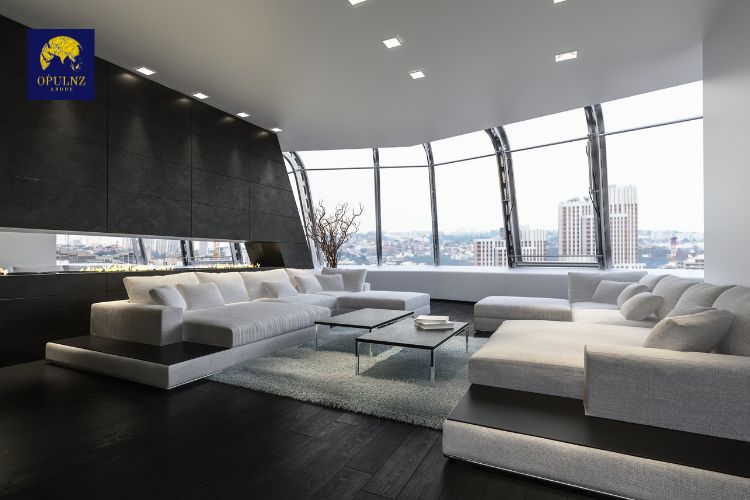Team OpulnzAbode: 02-12-2023, 8:15 am: Read Time – 1.2 mins
Introduction: Revolutionizing Urban Transit
With its thriving cities and burgeoning urban populace, India has undergone a remarkable metamorphosis in its public transportation paradigm. Amidst various transit modes, metro rail systems have emerged as pivotal constituents, offering rapid and effective connectivity in major metropolitan hubs. The advent of metro networks has not only alleviated strain on road infrastructure but has seamlessly woven into the daily commute of millions.
Delhi Metro: Navigating the Capital
Redefining Connectivity- Delhi Metro unfolds a tapestry of connectivity, crisscrossing the cityscape:
Red Line: Linking Shaheed Sthal to Rithala, spanning 34.55 km with 29 stations.
Yellow Line: 49 km from Samaypur Badli to HUDA City Centre, featuring 37 stations.
Blue Line: Covering 56.11 km, connecting Noida Electronic City to Dwarka Sector 21 with 50 stations.
Green Line: Spanning 28.79 km from Inderlok to Brigadier Hoshiyar Singh, with key interchanges at Ashok Park Main and Kirti Nagar among its 23 stations.
Violet Line: Encompassing 46.34 km, linking Kashmiri Gate to Raja Nahar Singh, including the vital Airport Express link across 34 stations.
Orange Line: Enabling connectivity over 22.91 km and 6 stations from New Delhi to Dwarka Sector 21.
Pink Line: A 38-station route extending 59.24 km, connecting Majlis Park to Shiv Vihar.
Magenta Line: Covering 37.46 km with 25 stations, the route joins the Botanical Garden to Janakpuri West.
Grey Line: Over 5.19 km, connecting Dwarka to the Dhansa Bus Stand with 4 stations.
Mumbai Metro: Navigating the Financial Hub
Enhancing Connectivity in Mumbai
Mumbai Metro, a lifeline for the city:
Blue Line: Versova–Andheri–Ghatkopar, covering 11.40 km with 12 stations.
Yellow Line: Divided into 2A (Dahisar-Charkop-Andheri West) and 2B (Andheri West-Mandala), partially opened with 18.5 km and 23.6 km, respectively.
Aqua Line: Under construction, spanning Colaba – Bandra – SEEPZ, covering 33.5 km with 27 stations.
Green Line: Under construction, covering Wadala–Ghatkopar-Mulund–Teen Hath Naka–Kasarvadavali, with an additional 4A route (Kasarwadavali-Gaimukh) under construction.
Orange Line: Under construction, connecting Thane-Bhiwandi-Kalyan.
Pink Line: Under construction, from Lokhandwala-Jogeshwari-Kanjurmarg.
Red Line: Under construction, spanning Dahisar (East) – Andheri (East), with a 7A route (Andheri-CSMIA) under construction.
Gold Line: Proposed route from CSMIA T2-NMIA.
Green Line: The approved route from Gaimukh-Shivaji Chowk (Mira Road) with a Wadala-CSMT line was also approved.
Orange Line: Approved route from Kalyan-Dombivali-Taloja.
Purple Line: To Be Announced (TBA) from Mira Bhayander-Virar.
Magenta Line: Proposed route from Kanjurmarg-Badlapur.
Kolkata Metro: The Oldest Urban Network
Legacy of Connectivity
Kolkata Metro, an epitome of history and efficiency:
Blue Line: Dakshineswar to Kavi Subash.
Green Line: Salt Lake to Sealdah, with plans for extension linking Howrah and Tigharia.
Bengaluru Metro: Silicon Valley’s Lifeline
Pioneering Urban Connectivity
Bengaluru Metro, spearheading southern India’s transit revolution:
Purple Line: Operational from Whitefield to Kengeri with 37 stations.
Green Line: From Nagasandra to Silk Institute with an ongoing extension to Bengaluru International Exhibition Centre (BIEC).
Yellow Line: Upcoming, 18 km, with 16 stations from Rashtriya Vidyalaya Road to Bommasandra.
Blue Line: Two-phase extension covering 58.19 km with 30 stations, including an airport link.
Pink Line: Future extension from Nagawara to Gottigere with 18 stations.
Orange Line: Part of Phase 3, spanning 31 km in 21 stations along the Outer Ring Road from JP Nagar to Hebbal, with Corridor II extending from Hosahalli Toll to Kadabagere.
Efficient Operations
Bengaluru Metro accommodates diverse schedules, operating from 5:05 AM to 11:30 PM on weekdays and from 7:00 AM on Sundays. Fares range from Rs 10 to Rs 45, ensuring affordability and accessibility. As of April 2023, the network’s ridership averages 700,000 passengers daily, attesting to its integral role in Bengaluru’s public transit dynamics.
Chennai Metro: South India’s Swift Transit
Comprehensive Network
Chennai Metro, seamlessly connecting the south:
Blue Line: 26 stations from Wimco Nagar to Chennai International Airport.
Green Line: 17 stations linking MGR Central to St Thomas Mount, with future expansion plans towards Howrah and Tigharia.
Hyderabad Metro: Pearls’ Interconnected Network
Strategic Connectivity
Hyderabad Metro, a comprehensive web across 57 stations:
Red Line: Miyapur to LB Nagar, spanning vital areas.
Blue Line: 27 km from Raidurg to Nagole, enhancing efficiency.
Green Line: JBS PG to MGBS, broadening accessibility.
Pune Metro: Rising Urban Web
Expanding Connectivity
Pune Metro, evolving with three lines:
Purple Line: Operational from Pimpri-Chinchwad Municipal Corporation to Swargate.
Aqua Line: Connecting Vanaz to Ramwadi, augmenting city connectivity.
Red Line: Under construction, linking Quadron to Civil Court.
Jaipur Metro: Pink City’s Commute
Dual-Phase Operation
Jaipur Metro operates in two phases:
Pink Line (Phase I): Mansarovar to Badi Chaupar, operational with 11 stations.
Orange Line (Phase II): Sitapura to Ambabari is under construction with 20 stations.
Convenient Operations
Operating from 6:20 AM to 9:49 PM, Jaipur Metro offers a dependable commute. Fares range from Rs 12 to Rs 18, catering to various budgets. The network’s daily ridership stands at an impressive 50,000 passengers.
Kochi Metro: Kerala’s Urban Marvel
Rapid Construction and Expanding Network
Kochi Metro, a 25 km network completed in four years:
Operational Phase: Aluva to Tripunithura Railway Station, covering 24 stations.
Pink Line (Phase 2): Underway with 11.2 km extension to Jawaharlal Nehru International Stadium to Infopark, scheduled for completion by 2028.
Phase 3: Proposed extension from Aluva to Cochin International Airport with 14 stations.
Efficient Operations
Operational from 6:20 AM to 10:30 PM, Kochi Metro caters to diverse travel needs with fares from Rs 10 to Rs 60. Boasting a ridership of 10,00,000 to 15,00,000 passengers daily, Kochi Metro has become integral to the city’s transportation fabric.
Lucknow Metro: Nawabi Commute
Dual-Line Dynamics
Lucknow Metro, comprising Red and Blue Lines:
Red Line: Operational, 8.5 km with 8 stations from Transport Nagar to Charbagh.
Blue Line: 11.10 km from Charbagh to Vasant Kunj, expected to be operational in 2026.
Consistent and Accessible Services
Lucknow Metro operates daily from 6:00 AM to 11:00 PM and ensures reliability and accessibility. Fares range from Rs 12 to Rs 50, making it a popular choice with a daily ridership of 60,000 passengers.
Ahmedabad Metro: Gujarat’s Urban Hub
Operational and Expanding Phases
Ahmedabad Metro’s operational phase:
Blue Line (East-West Corridor): Thaltej to Vastral Gram with 17 stops.
Red Line (North-South Corridor): Motera Stadium to APMC with 15 stops.
Budget-Friendly Operations
From 10:05 AM to 6:00 PM, Ahmedabad Metro ensures affordable transportation with fares from Rs 5 to Rs 10.
Noida Metro: NCR’s Transit Backbone
Aqua Line: Bridging Noida and Greater Noida
Noida Metro, spanning 29.7 km with 21 stations, operates daily from 6:05 AM to 10:00 PM. Fares range from Rs 15 to Rs 50.
Nagpur Metro: Maharashtra’s Expanding Network
Orange and Aqua Lines: Pioneering Eco-Friendly Transit
Nagpur Metro’s two lines, operational from 8 AM to 8:55 PM, span 22 km and boast eco-conscious features, contributing to the city’s sustainability goals.
Gurugram Metro: Haryana’s Structured Network
Efficient Network Design
Rapid Metro in Gurugram covers 12.85 km with 11 stations, operating daily from 6:00 AM to 11:00 PM. Fares are set at Rs 30 for consistent affordability.
Kanpur Metro: Expanding Connectivity
Orange and Blue Lines: Future Prospects
Kanpur Metro’s operational Orange Line, extending to Naubastra, is set to expand with the Blue Line, connecting Agriculture University to Barra-8.
Agra Metro: Transforming City Transit
Promising Connectivity
The Agra Metro, under construction, aims to cover 29.6 km with two corridors, providing efficient commuting options for residents.
Conclusion: Shaping Urban Futures
In conclusion, India’s metro maps signify a commitment to modern and efficient urban transit. These expanding networks, weaving through the intricate cityscapes, not only facilitate daily commutes but also contribute to economic growth, elevating the quality of life for millions. Source: https://timesproperty.com/news/post/metro-maps-for-top-cities-of-india-blid6135


































































































































































































































































































